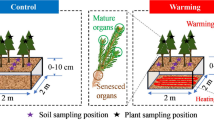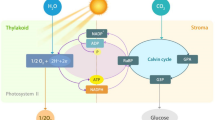Abstract
Responses of photosynthesis and the partition of energy utilization to high-nitrogen importation and high-light intensity in leaves of three dominant tree species of subtropical forest, including sun plant or early-successional species Schima superba, mesophyte or intermediate-successional species Canstanopsis hystrix, and shading-tolerant plant or late-successional species Cryptocarya concinna were studied by using the CO2 exchange system and chlorophyll fluorescence method. Our results showed that, regardless of plant species, net photosynthetic rate (Pn) was higher in high-nitrogen supply and high irradiance (HNHL) plants than in low-nitrogen supply and high irradiance (LNHL) plants, implying that low-nitrogen importation would limit Pn of plants grown under high irradiance. However, high-nitrogen supply and low irradiance (HNLL) plants had a lower Pn. Insignificant change of quantum yield (Fv′/Fm′) in opened PS II was found in leaves of HNHL, LNHL or HNLL plants of S. superba and C. hystrix, while a higher Fv′/Fm′ occurred in HNHL plants of C. concinna in comparison with LNHL or HNLL plants. The HNHL plants of C. concinna also had a higher photochemical quantum yield (ΔF/Fm′) than LNHL or HNLL plants, however no similar responses were found in plants of S. superba and C. hystrix (P <0.05). In the irradiance range of 0–2000 μmol photon·m−2 ·s−1, the fraction of energy consumed by photochemistry (ϕPSII) was 18.2% in LNHL plants of S. superba which was higher than that in HNHL plants (P>0.05) and it was significantly higher than in HNLL plants (P<0.05). C. hystrix also had a similar response in ϕPSII to nitrogen supply and irradiance. Regardless of species HNLL plants had a significant ϕPSII and higher heat dissipation in light, and this effect was more severe in C. concinna than in S. superba or C. hystrix. The results may mean that high-nitrogen importation by nitrogen deposit and low irradiance caused by changing climate or air pollution would more severely restrict photosynthetic processes in the late-successional species C. concinna than in the early-successional species S. superba and intermediate-successional species C. hystrix. The continuous high-nitrogen precipitation in the future and the over cast mist or pollution smoke could induce late-successional species to degrade, however, early-successional species would be more adapted to competition for more resources to keep their dominance in ecosystems. In this sense, the zonal vegetation may accelerate degradation caused by high nitrogen precipitation and low irradiance, while the early-successional and mesophytic vegetations can remain longer. Thus, nitrogen precipitation may play an important role in plant community succession.
Similar content being viewed by others
References
Galloway J N. The global nitrogen cycle: Changes and consequences. Environ Pollut, 1998, 102: 15–24, 10.1016/S0269-7491(98)80010-9, 1:CAS:528:DyaK1MXjvVartQ%3D%3D
Holland E A, Dentener F J, Braswell B H, et al. Contemporary and preindustrial global reactive nitrogen budgets. Biogeochemistry, 1999, 46: 7–43, 1:CAS:528:DyaK1MXlslSmu7s%3D
Vitousek P M, Aber J D, Howarth R W, et al. Human alteration of the global nitrogen cycle: Sources and consequences. Ecol Appl, 1997, 7: 737–750
Nakaji T, Fukami M, Dokiya Y, et al. Effects of high nitrogen load on growth, photosynthesis and nutrient status of Crypfomeria japonica and Pinica densiflora seedlings. Tree, 2001, 15: 453–461, 1:CAS:528:DC%2BD38XhtV2ru7g%3D
Warren C R, Dreyer E, Adams M A. Photosynthesis-Rubisco relationships in foliage of Pinus sylvestris in response to nitrogen supply and the proposed role of Rubisco and amino acids as nitrogen stores. Trees, 2003, 17: 359–366, 1:CAS:528:DC%2BD3sXksFGlurk%3D
Thelin G, Rosengren U, Callesen I, et al. The nutrient status of Norway spruce in pure and in mixed-species stands. For Ecol Manage, 2002, 160: 115–125, 10.1016/S0378-1127(01)00464-9
Mattson W J. Herbivory in relation to plant nitrogen content. Annu Rev Ecol Syst, 1980, 11: 119–161, 10.1146/annurev.es.11.110180.001003
Balsberg P A M. Influence of nitrogen fertilization on minerals, carbohydrates, amino acids and phenolic compounds in beech (Fagus sylvatica L.) leaves. Tree Physiol, 1992, 10: 93–100
Strengbom J, Nordin A, Näsholm T, et al. Parasitic fungus mediates change in nitrogen-exposed boreal forest vegetation. J Ecol, 2002, 90: 61–67, 10.1046/j.0022-0477.2001.00629.x
Tilman D. Species richness of experimental productivity gradients: How important is colonization limitation. Ecology, 1993, 74: 2179–2191, 10.2307/1939572
Högberg P, Fan H B, Quist M, et al. Tree growth and soil acidification in response to 30 years of experimental nitrogen loading on boreal forest. Glob Change Biol, 2006, 12: 489–499, 10.1111/j.1365-2486.2006.01102.x
Magill A H, Aber J D, Berntson, et al. Long-term nitrogen additions and nitrogen saturation in two temperate forests. Ecosystems, 2000, 3: 238–253, 10.1007/s100210000023
Heij G J, Schneider T. Acidification Research in the Netherlands. Amsterdan: Elsevier, 1991. 51–137
Zhou G Y, Yan J H. The influences of regional atmospheric precipitation characteristics and its element inputs on the existence and development of Dinghushan forest ecosystems. Acta Ecol Sin (in Chinese), 2001, 21(12): 2002–2012
Mo J M, Xue J H, Fang Y T. Litter decomposition and its responses to simulated N deposition for the major plants of Dinghushan forests in subtropical China. Acta Ecol Sin (in Chinese), 2004, 24(7): 1413–1420
Aber J, McDowell W, Nadelhoffer K, et al. Nitrogen saturation in temperate forest ecosystems: Hypotheses revisited. Bioscience, 1998, 48: 921–934, 10.2307/1313296
Peng S L, Wang B S. Forest succession at Dinghushan, Guangdong, China. Bot J South China (in Chinese), 1993, 2: 34–42
Demmig-Adams B, Adams W W III, Baker D H, et al. Using chlorophyll fluorescence to assess the fraction of absorbed light allocated to thermal dissipation of excess excitation. Physiol Plant, 1996, 98: 253–264, 10.1034/j.1399-3054.1996.980206.x, 1:CAS:528:DyaK28XmsVChtL4%3D
Genty B, Briantais J M, Baker N R. The relationship between the quantum yield of photosynthetic electron transport and quenching of chlorophyll fluorescence. Biochim Biophys Acta, 1989, 990: 87–92, 1:CAS:528:DyaL1MXhsFWntL4%3D
Harbinson J, Genty B, Baker N R. Relationship between the quantum efficiencies of photosystems I and II in pea leaves. Plant Physiol, 1989, 90: 1029–1034, 16666847, 1:CAS:528:DyaL1MXkvFCjtro%3D, 10.1104/pp.90.3.1029
Melis A, Spangfort M, Andersson B. Light-absorption and electron-transport balance between photosystem II and photosystem I in spinach chloroplasts. Photochem Photobiol, 1987, 45: 129–136, 10.1111/j.1751-1097.1987.tb08413.x, 1:CAS:528:DyaL2sXhtlGmsrY%3D
Epron D, Godard D, Cornic G, et al. Limitation of net CO2 assimilation rate by internal resistances to CO2 transfer in the leaves of two tree species (Fagus sylvatica and Castanea sativa Mill). Plant Cell Environ, 1995, 18: 43–51, 10.1111/j.1365-3040.1995.tb00542.x
Valentini R, Epron D, De Angelis P, et al. In situ estimation of net CO2 assimilation, photosynthetic electron flow and photorespiration in Turkey oak (Quercus cerris L.) leaves: Diurnal cycles under different levels of water supply. Plant Cell Environ, 1995, 18: 631–640, 10.1111/j.1365-3040.1995.tb00564.x, 1:CAS:528:DyaK2MXmvFKks70%3D
Atkin O K, Evans J R, Ball M C, et al. Leaf respiration of snow gum in the light and dark. Interaction between temperature and irradiance. Plant Physiol, 2000, 122: 915–923, 10712556, 10.1104/pp.122.3.915, 1:CAS:528:DC%2BD3cXktFSqt7k%3D
Evans J R, Poorter H. Photosynthetic acclimation of plants to growth irradiance: The relative importance of specific leaf area and nitrogen partitioning in maximizing carbon gain. Plant Cell Environ, 2001, 24: 755–767, 10.1046/j.1365-3040.2001.00724.x, 1:CAS:528:DC%2BD3MXmsFCmurk%3D
Grassi G, Meir P, Cromer R, et al. Photosynthetic parameters in seedlings of Eucalyptus grandis as affected by rate of nitrogen supply. Plant Cell Environ, 2002, 25: 1677–1688, 10.1046/j.1365-3040.2002.00946.x
Warren C R, Adams M A. Distribution of N, Rubisco and photosynthesis in Pinus pinaster and acclimation to light. Plant Cell Environ, 2001, 24: 597–609, 10.1046/j.1365-3040.2001.00711.x, 1:CAS:528:DC%2BD3MXltVOgtbw%3D
Cheng L, Fuchigami L H. Rubisco activation state decrease with increasing nitrogen content in apple leaves. J Exp Bot, 2000, 51: 1687–1694, 11053458, 10.1093/jexbot/51.351.1687, 1:CAS:528:DC%2BD3cXotVWis74%3D
Field C, Mooney H A. The photosynthesis-nitrogen relationship in wild plant. In: Givnish T J, ed. On the Economy of Form and Function. Cambridge: Cambridge University Press, 1986. 25–55
Gabrielson E K. Effects of different chlorophyll concentration on photosynthesis in foliage leaves. Physiol Plant, 1948, 1: 5–37, 10.1111/j.1399-3054.1948.tb07108.x
Kramer D M, Johnson G, Kiirats O, et al. New fluorescence parameters for the determination of QA redox state and excitation energy fluxes. Photosynth Res, 2004, 79: 209–218, 16228395, 10.1023/B:PRES.0000015391.99477.0d, 1:CAS:528:DC%2BD2cXhtV2qu70%3D
Kato M C, Hikosaka K, Hirotsu N, et al. The excess light energy that is neither utilized in photosynthesis nor dissipated by photoprotective mechanisms determines the rate of photoinactivation in photosystem II. Plant Cell Physiol, 2003, 44: 318–325, 12668778, 10.1093/pcp/pcg045, 1:CAS:528:DC%2BD3sXivVWit70%3D
Andersson B, Barber J. Mechanisms of photodamage and protein degradation during photoinhibition of Photosystem II. In: Baker N R, ed. Photosynthesis and the Environment. Dordrecht: Kluwer Academic Publishers, 1996. 101–121
Hikosaka K, Kato M C, Hirose T. Photosynthetic rate and partitioning of light energy in photoinhibited leaves. Physiol Plant, 2004, 121: 699–708, 10.1111/j.1399-3054.2004.00364.x, 1:CAS:528:DC%2BD2cXntVeru7c%3D
Farquhar G D, von Caemmerer S. Modelling of photosynthetic response to environmental conditions. In: Lange O, Nobel P, Osmond C B, et al., eds. Encyclopaedia of Plant Physiology, Vol. 12B. Physiological Plant Ecology II: Water Relations and Carbon Assimilation. Berlin: Springer Verlag, 1982. 549–587
Author information
Authors and Affiliations
Corresponding author
Additional information
Supported by the National Natural Science Foundation of China (Grant Nos. 30428022 & 30770328), Provincial Natural Science Foundation of Guangdong (Grant No. 07006917), and Knowledge Innovation Program of the Chinese Academy of Sciences (Grant No. KZCX2-SW-133)
Rights and permissions
About this article
Cite this article
Cai, X., Sun, G., Zhao, P. et al. High-nitrogen and low-irradiance can restrict energy utilization in photosynthesis of successional tree species in low subtropical forest. SCI CHINA SER C 51, 592–603 (2008). https://doi.org/10.1007/s11427-008-0077-x
Received:
Accepted:
Published:
Issue Date:
DOI: https://doi.org/10.1007/s11427-008-0077-x




